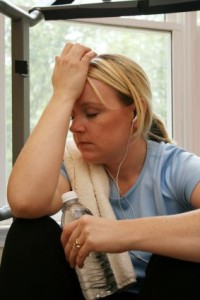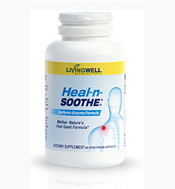 Everyone has “on” days and “off” days, but if you’re “off” at the gym you’ll likely be wasting both your time and energy.
Everyone has “on” days and “off” days, but if you’re “off” at the gym you’ll likely be wasting both your time and energy.
Finding the time to work out is one of the biggest hurdles people face in fitting in exercise, after all, so when you make the time to do it, you want to be sure you’re maximizing your efforts.
Obviously, in order to be at your best, you’ll need a good night’s sleep and proper nutrition to fuel your body.
Far less obvious are the nine things that follow, which can hurt your workout in very unexpected ways.[i]
Don’t Let These 9 Odd Things Hurt Your Workout Results
9. Exercising Indoors, Especially In These Situations…
A dimly lit, crowded or smelly gym will zap your motivation, and if you don’t like where you’re working out you’ll be far less likely to do it. On the other hand, exercising outdoors offers numerous benefits (above and beyond the exercise itself), like decreased tension, anger and depression, and a greater likelihood of continued exercise.[ii] According to research:[iii]
“Compared with exercising indoors, exercising in natural environments was associated with greater feelings of revitalization and positive engagement, decreases in tension, confusion, anger, and depression, and increased energy … Participants reported greater enjoyment and satisfaction with outdoor activity and declared a greater intent to repeat the activity at a later date.”
8. Exercising Outdoors During Rush Hour …
Outdoor exercise is great … but don’t do it near heavy traffic when air pollution is likely to be at its peak. There are many reasons to avoid exposure to air pollution, but from a fitness standpoint, high levels of smog have been found to slow performance times in women athletes.[iv]
7. Exercising Alone
 It’s easier to skip a workout if no one is waiting for you to join them. Plus, research shows that working out in groups may lead to a greater endorphin release and higher pain tolerance compared to working out alone.[v]
It’s easier to skip a workout if no one is waiting for you to join them. Plus, research shows that working out in groups may lead to a greater endorphin release and higher pain tolerance compared to working out alone.[v]
6. Hormone Fluctuations in Women
During ovulation, higher estrogen levels may make your muscles more lax and prone to injury. It may make sense for women to consider gentler forms of exercise during ovulation for this reason, especially if you’ve been injured previously.[vi]
5. Low Iron Levels
If you have low iron levels, you may suffer from fatigue and low endurance (even if you’re not anemic). One study found that blood lactate levels, which are used as an indicator of muscle fatigue, are also about 10 percent lower in women taking a daily iron supplement compared to those taking a placebo. Correcting low iron levels lead to improved energetic efficiency in the female athletes.[vii] It’s estimated that about 30 percent of physically active women may be low in iron.[viii]
4. Over the Counter Medications
Common medications can impact your workout in a variety of ways. Many increase drowsiness, for instance, while others may make you feel jittery. Ibuprofen and decongestants may increase your blood pressure, which could be dangerous during an intense workout.
3. Not Taking Time for Recovery
Exercise is a form of stress and your body needs time to recover properly afterward. You generally need about 48 hours of recovery following high-intensity exercise, 48-72 hours after strength training and 24-36 hours after yoga.[ix] In addition to rest time, you also need to fuel your body properly after a workout in order to replenish lost nutrients and energy stores.
In particular, your body will typically use up the glycogen stores in your muscles for energy during exercise. Most experts recommend eating a healthful snack that contains both protein and carbohydrates within 30 minutes of your workout.
2. You’re Too Used to Your Routine
Doing the same fitness routine day-in and day-out is not only boring but your muscles will quickly adapt to the movements. This means you’ll stop seeing additional results, unless you push yourself past this workout “plateau.” Strive to include a wide variety of activities in your workouts to challenge your muscles in different ways, and use interval training to keep the intensity up.
1. Soreness From a Previous Workout
 When you work your muscles, it can cause tiny injuries or ‘microdamage” to your muscle fibers and connective tissues. This can lead to delayed-onset muscle soreness (DOMS), which typically occurs 12 to 24 hours after a workout. According to the American College of Sports Medicine, DOMS is a side effect of the repair process that develops in response to microscopic muscle damage.[x]
When you work your muscles, it can cause tiny injuries or ‘microdamage” to your muscle fibers and connective tissues. This can lead to delayed-onset muscle soreness (DOMS), which typically occurs 12 to 24 hours after a workout. According to the American College of Sports Medicine, DOMS is a side effect of the repair process that develops in response to microscopic muscle damage.[x]
It can cause not only muscle soreness but also swelling, stiffness, tenderness to the touch and temporary reduction in strength to the affected muscles.
So, you should be sure to give your muscles time for recovery before pushing them to their limits again. AND, you should keep a ready supply of Heal-n-Soothe, which is an all-natural inflammation fighter that promotes healthy muscle repair to minimize post-workout pain.
Heal-n-Soothe’s secret weapon for your recovery is its concentrated dose of proteolytic enzymes. These enzymes eat excess fibrin and scar tissue for lunch, helping every microscopic muscle tear to heal properly to deliver a full range of motion while reducing inflammation, tightness and pain.
These enzymes work at a cellular level, ensuring your workout recovery starts from the inside out (plus, it also contains 12 of nature’s best anti-inflammatory compounds), so you don’t have to worry about missing a workout due to pain.
[i] Prevention.com
[ii] Prevention.com
[iii] Environ. Sci. Technol., 2011, 45 (5), pp 1761–1772
[iv] Med Sci Sports Exerc. 2010 Mar;42(3):585-91.
[v] University of Oxford September 16, 2009
[vi] Prevention.com
[vii] Med Sci Sports Exerc. 2014 Jun;46(6):1204-15.
[viii] Women’s Health Magazine December 17, 2013
[ix] Prevention.com
[x] American College of Sports Medicine, Delayed Onset Muscle Soreness


